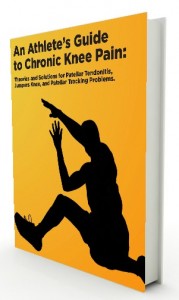Do your knees go snap, crackle, and pop? If they do you, then it’s likely that you have runners knee.
Patellar Tracking Disorder, also known as runners knee, is a common overuse injury where the knee cap (patella) shifts out of place, or “off track” as the leg bends and straightens.
Achy pain in the front of the knees combined with popping, clicking or grinding noises is characteristic while doing activities like running, jumping, climbing or descending stairs.
For some, the pain will be felt immediately after rising from a seated position that has been sustained for a long period with the knees bent.
According to Michael Young, NCTMB and developer of the Muscle Release Technique, what’s pulling the patella out of its track is an imbalance in the quadriceps (thigh muscles).
The quadriceps connect to the patellar tendon, which goes over the top of the patella, and when they become too tight, they pull the patella out of its track.

The vastus medialis is the only quadriceps muscle that has a medial pull, so when it’s up against the other three, it’s a losing battle, and the patella gets pulled toward the outside of the leg.
Healthcare professionals usually recommend strengthening the weak vastus medialis muscle in order to fix the muscle imbalance and correct the patellar tracking.
This is a great plan, however, what sometimes happens is the quadriceps get overworked, making them more tight and contracted, thus pulling the patella out of alignment.
There is a BIG difference between a strong muscle and a tight one. A tight muscle can be very weak and offer virtually no protection for a joint. A tight muscle is an inefficient muscle…Tightness doesn’t help-in fact, it hurts.
Stretching out tight quads seems like a pretty simple task, however, most people end up hitting only three of the quad muscles and not the most important one- the rectus femoris.
The rectus femoris happens to be the only quad muscle that attaches above the hip, making it also a hip flexor.
“Often we see runners stretching their quads prior to starting their run,” says Young. “Most people stretch by grabbing the ankle and pulling the heel towards the gluteus maximus while bending over. As soon as the person bends over, he takes the rectus femoris out of the stretch.” By isolating and stretching a tight rectus femoris, the patella will track properly without the need for medical intervention.
Avoid Runners Knee by Stretching Your Rectus Femoris
There are several ways to stretch the rectus femoris. An effective method is by using a Thera-Band Stretch Strap.
Watch the video below to see to use the stretch strap to avoid runner’s knee.
For an extra boost in avoiding runner’s knee, check out an Athlete’s Guide to Chronic Knee Pain is for those with chronic knee problems (tendonitis, tendonosis, tracking issues), that want a better understanding of how chronic knee problems are created, that are willing to work hard to conquer their pain, looking to learn how to put less stress.
For professional massage and stretching assistance, schedule a professional sports massage.
You might also be interested in…


